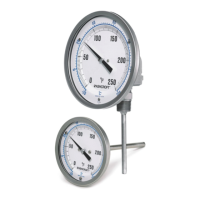
Do you have a question about the Ashcroft A and is the answer not in the manual?
| Type | Pressure Gauge |
|---|---|
| Dial Size | 2.5" |
| Connection Size | 1/4" NPT |
| Connection Location | Lower, Back |
| Case Material | Stainless steel |
| Window Material | Acrylic, Glass |
| Fill Fluid | Glycerin, Silicone |
Outlines the manual's purpose, intended audience, and key information.
Explains warning/information symbols and manufacturer contact details.
Identifies general hazards and defines the device's specific application.
Details operator duties and required personnel qualifications for safe operation.
Defines permissible zones, environmental conditions, and standards for explosive atmospheres.
Specifies maximum permissible media temperatures for different device executions.
Lists maximum surface temperatures based on gas/vapour ignition classes.
Explains dust ignition temperature determination and surface limits.
Provides maximum surface temperature limits for dust clouds and layers.
Explains device labeling for ATEX and UKCA compliance, including EPL and temperature classes.
Describes the details found on the device's nameplate, including type designation and markings.
Lists the main components of the bimetal thermometer.
Explains how the bimetallic coil and shaft transfer temperature to the pointer.
Details the stem, dial, pointer, and instrument connection.
Information on available accessories and special sealing materials.
Guidelines for checking delivery for completeness, damage, and proper storage.
Steps for preparation and checks for the installation location.
Procedure for adjusting the optional every angle connection.
Details on process connection types, materials, and installation requirements.
Procedures for starting the device and adjusting the zero point.
Instructions for safely moving the thermometer to a new measuring point.
Procedures and recommended intervals for checking and recalibrating the device.
Guidelines for cleaning the device and performing routine maintenance.
Lists common faults, their possible causes, and recommended corrective actions.
References assembly and installation procedures after fault correction.
Steps for safely dismantling the device, including necessary precautions.
Guidelines for proper disposal of the product at the end of its lifecycle.
Refers to detailed data sheets for specific models available from the manufacturer.
